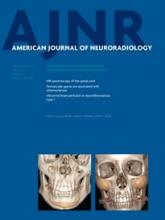Research ArticleBrain
Open Access
Perivascular Spaces Are Associated with Atherosclerosis: An Insight from the Northern Manhattan Study
J. Gutierrez, T. Rundek, M.S.V. Ekind, R.L. Sacco and C.B. Wright
American Journal of Neuroradiology September 2013, 34 (9) 1711-1716; DOI: https://doi.org/10.3174/ajnr.A3498
J. Gutierrez
aFrom the Department of Neurology (J.G., M.S.V.E.), College of Physicians and Surgeons
T. Rundek
cDepartment of Neurology (T.R., R.L.S., C.B.W.), Miller School of Medicine, University of Miami, Miami, Florida.
M.S.V. Ekind
aFrom the Department of Neurology (J.G., M.S.V.E.), College of Physicians and Surgeons
bDepartment of Epidemiology (M.S.V.E.), Mailman School of Public Health, Columbia University, New York, New York
R.L. Sacco
cDepartment of Neurology (T.R., R.L.S., C.B.W.), Miller School of Medicine, University of Miami, Miami, Florida.
C.B. Wright
cDepartment of Neurology (T.R., R.L.S., C.B.W.), Miller School of Medicine, University of Miami, Miami, Florida.

REFERENCES
- 1.↵
- Durand-Fardel M
- 2.↵
- Poirier J,
- Derouesne C
- 3.↵
- Greenfield JG,
- Blackwood W,
- Corsellis JA
- 4.↵
- Bradbury MW,
- Cserr HF,
- Westrop RJ
- 5.↵
- Millen JW,
- Woollam DH
- 6.↵
- Pullicino PM,
- Miller LL,
- Alexandrov AV,
- et al
- 7.↵
- Wuerfel J,
- Haertle M,
- Waiczies H,
- et al
- 8.↵
- Cumurciuc R,
- Guichard JP,
- Reizine D,
- et al
- 9.↵
- Rollins NK,
- Deline C,
- Morriss MC
- 10.↵
- Zhu YC,
- Tzourio C,
- Soumare A,
- et al
- 11.↵
- Maclullich AM,
- Wardlaw JM,
- Ferguson KJ,
- et al
- 12.↵
- Sacco RL,
- Boden-Albala B,
- Gan R,
- et al
- 13.↵
- Boden-Albala B,
- Cammack S,
- Chong J,
- et al
- 14.↵
- Rundek T,
- Arif H,
- Boden-Albala B,
- et al
- 15.↵
- 16.↵
- Hughes W
- 17.↵
- Hughes W,
- Dodgson MC,
- Maclennan DC
- 18.↵
- Mitchell GF,
- Parise H,
- Benjamin EJ,
- et al
- 19.↵
- 20.↵
- Awad IA,
- Johnson PC,
- Spetzler RF,
- et al
- 21.↵
- Cole FM,
- Yates PO
- 22.↵
- 23.↵
- Fisher CM
- 24.↵
- 25.↵
- Noren D,
- Palmer HJ,
- Frame MD
- 26.↵
- Patankar TF,
- Mitra D,
- Varma A,
- et al
- 27.↵
- Groeschel S,
- Chong WK,
- Surtees R,
- et al
- 28.↵
- Bokura H,
- Kobayashi S,
- Yamaguchi S
- 29.↵
- 30.↵
- Jungreis CA,
- Kanal E,
- Hirsch WL,
- et al
- 31.↵
- Schick S,
- Gahleitner A,
- Wober-Bingol C,
- et al
- 32.↵
- Kwee RM,
- Kwee TC
- 33.↵
- Achiron A,
- Faibel M
- 34.↵
- Elster AD,
- Richardson DN
In this issue
American Journal of Neuroradiology
Vol. 34, Issue 9
1 Sep 2013
Advertisement
J. Gutierrez, T. Rundek, M.S.V. Ekind, R.L. Sacco, C.B. Wright
Perivascular Spaces Are Associated with Atherosclerosis: An Insight from the Northern Manhattan Study
American Journal of Neuroradiology Sep 2013, 34 (9) 1711-1716; DOI: 10.3174/ajnr.A3498
0 Responses
Jump to section
Related Articles
- No related articles found.
Cited By...
- Determinants of Perivascular Spaces in the General Population: A Pooled Cohort Analysis of Individual Participant Data
- Brain perivascular space imaging across the human lifespan
- Perivascular spaces contribute to cognition beyond other small vessel disease markers
- Perivascular Spaces in Old Age: Assessment, Distribution, and Correlation with White Matter Hyperintensities
- Brain Perivascular Spaces as Biomarkers of Vascular Risk: Results from the Northern Manhattan Study
- Vascular contributions to cognitive impairment
- Topography and associations of perivascular spaces in healthy adults: The Kashima Scan Study
- White Matter Perivascular Spaces Are Related to Cortical Superficial Siderosis in Cerebral Amyloid Angiopathy
This article has not yet been cited by articles in journals that are participating in Crossref Cited-by Linking.
More in this TOC Section
Similar Articles
Advertisement











